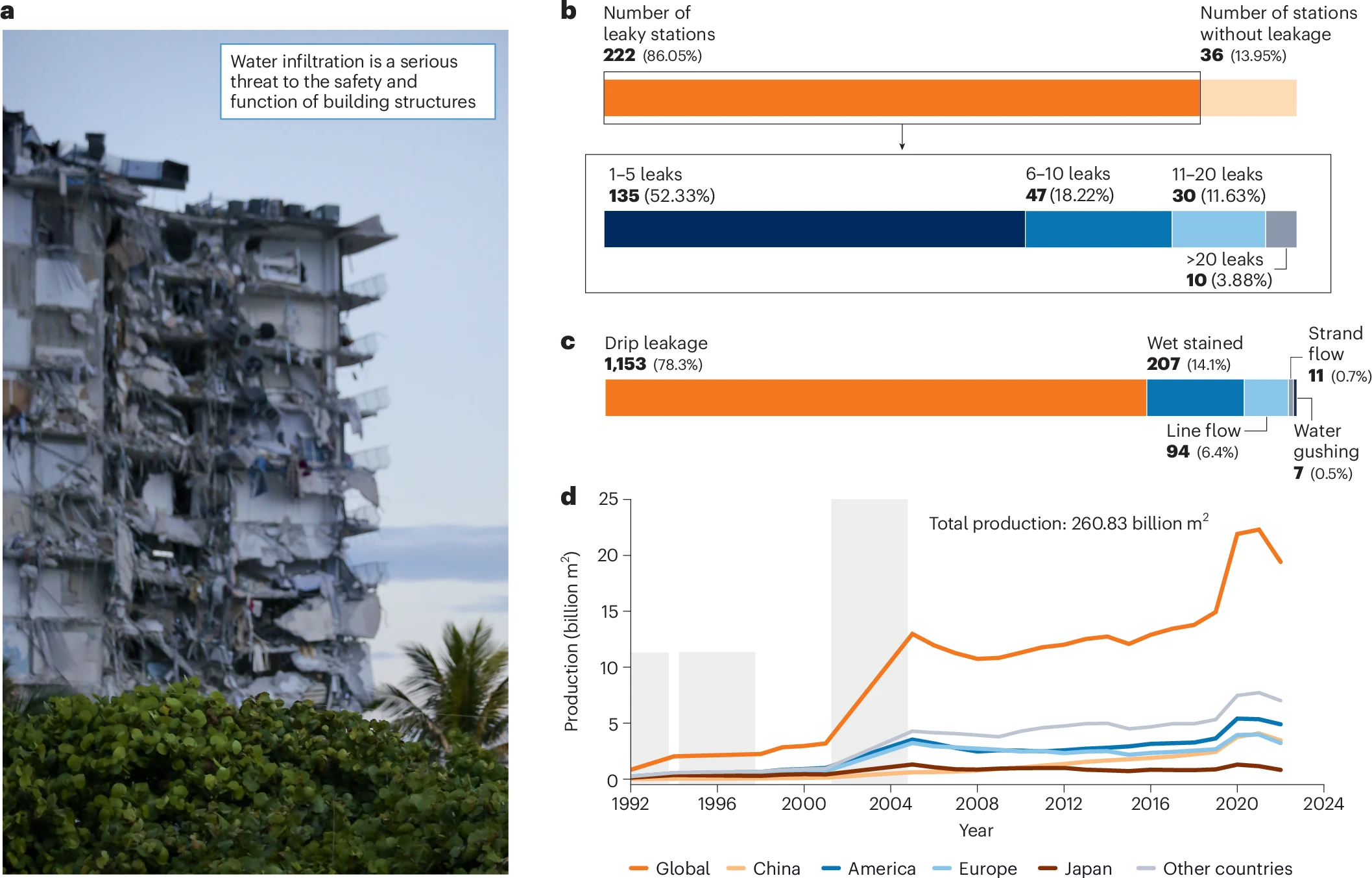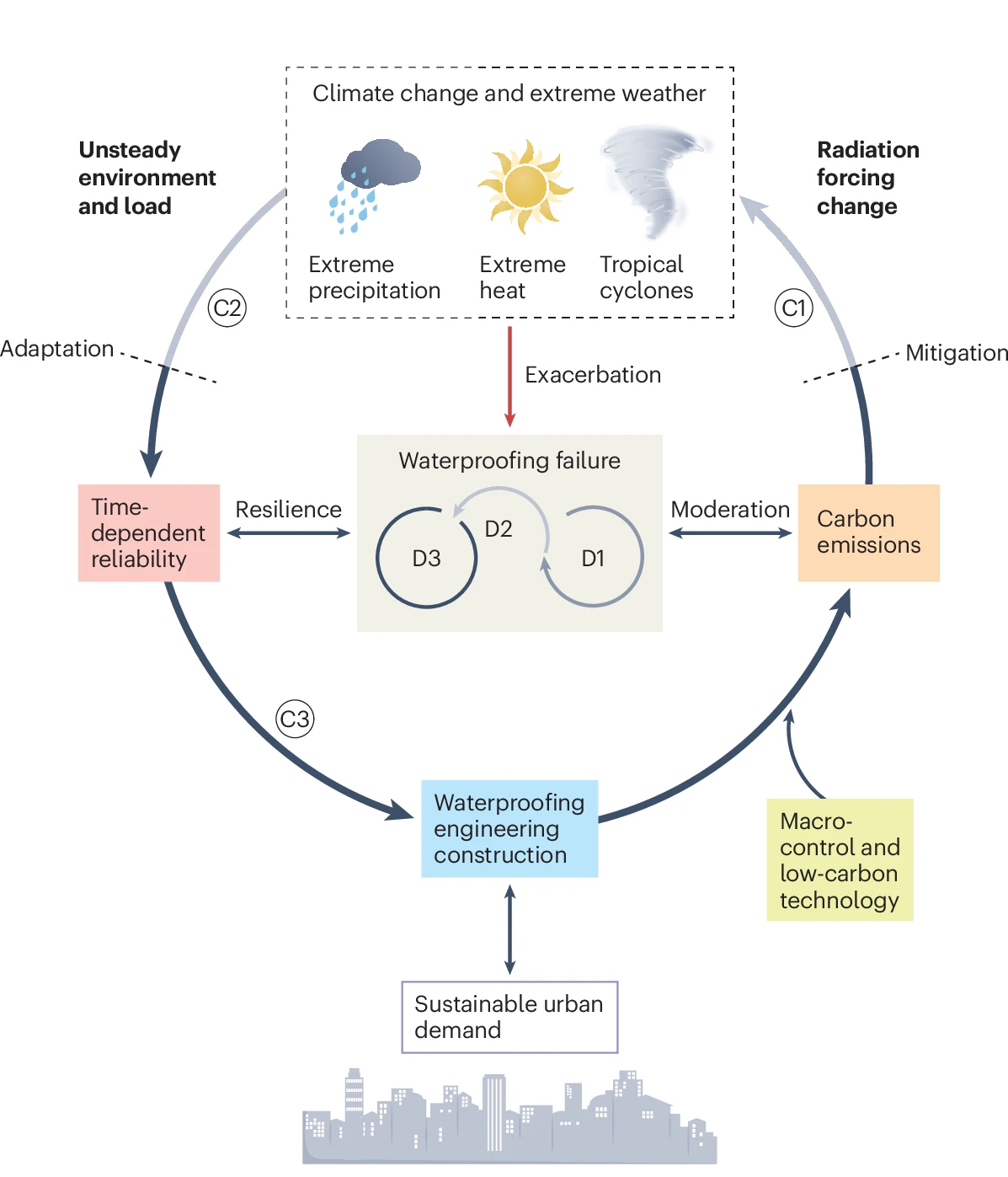Recently, Professor Xiao Jianzhuang, Dean of the Institute of Carbon Neutral Science and Technology of GXU and Director of the Green Construction Research Center of Tongji University, collaborated with prominent scholars worldwide including Chinese Academy of Engineering (CAE) Member Professor Xiao Xuwen from Tongji University, CAE Member Professor Wang Fuming from Zhengzhou University, CAE Foreign Member and Royal Academy of Engineering Fellow Professor Kang Jian from University College London, and Professor Jorge de Brito, Director of the CERIS Research Centre at Universidade de Lisboa. Their joint study conducted an in-depth analysis of the severe threats posed by building water leakage to global urban safety, functionality, and sustainability, critically reviewed the current state of building waterproofing technologies, and proposed actionable solutions that pioneer novel pathways for decarbonizing the construction industry worldwide. This research, entitled "Low-carbon solutions for water infiltration in urban buildings under climate change," has been published in the premier international journal Nature Cities (a Nature portfolio journal). Professor Xiao Jianzhuang served as the paper’s first author and corresponding author.

The construction sector accounts for 40% of global carbon emissions, making its decarbonization critical for achieving key strategic goals such as the Sustainable Development Goals (SDGs), the Paris Agreement, and carbon peaking/carbon neutrality targets. Over the past decade, low-carbon building materials have dominated decarbonization research in construction, while the significant potential of building waterproofing engineering to reduce carbon emissions has been largely overlooked.
To elaborate on the detrimental impacts of building water leakage on urban systems (Fig. 1), the study first analyzed its effects on urban functionality, safety, and sustainability. Regarding urban functionality and safety, water infiltration can cause critical urban buildings to lose essential functions and even trigger sudden safety incidents. Economically, such leakage may incur substantial costs, as exemplified by New Zealand's leaky building crisis (1995-2004), which affected approximately 89,000 homes and resulted in NZD $22.89 billion in losses. Socially, water damage has prompted numerous construction quality lawsuits and may contribute to sick building syndrome, negatively impacting residents' well-being and health. Environmentally, global production of flexible waterproofing materials over the past 24 years potentially reached 260.83 billion square meters, with associated cumulative carbon emissions estimated at 687 million metric tons.
The article notes that climate change poses new challenges to building waterproofing engineering, establishing a bidirectional detrimental cycle: extreme weather events like intensified rainfall and rising temperatures accelerate the aging of waterproofing materials and degradation of structural integrity, thereby shortening the service life of waterproofing systems. Conversely, the construction and renewal of these systems generate massive carbon emissions that further exacerbate climate change. Within this context, modern waterproofing engineering must simultaneously ensure both reliability and low-carbon performance.
Furthermore, the article summarizes the global status of building water leakage, revealing widespread and severe infiltration problems across regions (Fig. 2). In developing nations, basement leakage is prevalent in Kuwaiti residential buildings while tropical countries face acute roof leakage in high-rises; among developed economies, over 70% of newly built homes in Sweden experience frequent water seepage during heavy rainfall, and indoor water leakage accounts for 13% of total household water usage in American homes.
Confronting such severe water leakage challenges, current prevention strategies primarily rely on three technical approaches: material waterproofing, structural waterproofing, and leakage remediation. While innovative waterproofing cases have emerged, the field lacks a systematically established theoretical foundation, remaining largely experience-driven. Consequently, existing technologies struggle to scientifically ensure the reliability of waterproofing systems, with research into low-carbon solutions still in its nascent phase.
To address building water leakage challenges under climate change, the study proposes a sustainability-based waterproofing engineering philosophy (Fig. 3)
The framework first defines the boundaries of sustainable waterproofing engineering through a three-tiered defense system comprising drainage systems (D1), flexible waterproofing systems (D2), and rigid waterproofing systems (D3). Failure in drainage systems (D1) relates to rainfall intensity and drainage capacity limitations; compromise of flexible systems (D2) primarily stems from material deterioration or physical damage; while rigid systems (D3) fail predominantly due to interconnected pore networks within the material matrix. Crucially, waterproofing system failure occurs only when all three defense tiers are simultaneously compromised.
The framework subsequently establishes a sustainability-driven waterproofing design methodology focusing on two core objectives: developing time-variant reliability design principles that account for climate change adaptation, and formulating multipath regulation techniques to mitigate carbon emissions in waterproofing projects. The former enhances structural safety and extends service life, while the latter prioritizes carbon footprint reduction (Fig. 3), thereby simultaneously addressing reliability and low-carbon performance in sustainable waterproofing engineering.

Additionally, the article proposes concrete recommendations across four dimensions: policy incentives involving targeted subsidies, robust market regulation, and price stabilization mechanisms to address practical needs; standardization innovations through upgrading waterproofing engineering codes and establishing dedicated academic programs in higher education to cultivate specialized talent; research advancements focusing on sustainability-driven theoretical studies and technological development of low-carbon waterproofing materials and intelligent construction techniques, with particular emphasis on big data and AI applications; and service-life monitoring by promoting smart health assessment technologies to inspect in-service conditions of waterproofing systems and enable timely maintenance.
Finally, the study emphasizes that under climate change, building waterproofing engineering spans interdisciplinary domains including mechanics, materials science, environmental science, civil engineering, and management—constituting a critical cross-disciplinary challenge demanding collective societal engagement. This research not only offers novel perspectives for addressing such interdisciplinary complexities but also pioneers new pathways for decarbonizing the construction sector. Amidst climate pressures and carbon peaking/carbon neutrality goals, technological innovation-driven advancement in waterproofing engineering has become imperative for industry transformation and serves as vital practice for achieving green sustainable development.
Nature Cities, as part of the Nature Portfolio, specializes in urban studies and aims to foster a comprehensive understanding of cities and their evolving roles in a changing world, spanning research domains including natural sciences, social sciences, engineering, and humanities under the Nature.